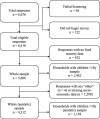Food insecurity among households with children during the COVID-19 pandemic: results from a study among social media users across the United States
- PMID: 34461913
- PMCID: PMC8403824
- DOI: 10.1186/s12937-021-00732-2
Food insecurity among households with children during the COVID-19 pandemic: results from a study among social media users across the United States
Abstract
Background: In the United States, approximately 11% of households were food insecure prior to the COVID-19 pandemic. The present study aims to describe the prevalence of food insecurity among adults and households with children living in the United States during the pandemic.
Methods: This study utilized social media as a recruitment platform to administer an original online survey on demographics and COVID-related food insecurity. The survey was disseminated through an advertisement campaign on Facebook and affiliated platforms. Food insecurity was assessed with a validated six-item United States Department of Agriculture (USDA) Household Food Security Survey Module, which was used to create a six-point numerical food security score, where a higher score indicates lower food security. Individual-level participant demographic information was also collected. Logistic regressions (low/very-low compared with high/marginal food security) were performed to generate adjusted odds ratios (AOR) and 95%CIs for food insecurity and select demographic characteristics.
Results: Advertisements reached 250,701 individuals and resulted in 5,606 complete surveys. Overall, 14.7% of participants self-identified as having low or very low food security in their households, with higher prevalence (17.5%) among households with children. Unemployment (AOR:1.76, 95%CI:1.09-2.80), high school or lower education (AOR:2.25, 95%CI:1.29-3.90), and low income (AOR[$30,000-$50,000]:5.87, 95%CI:3.35-10.37; AOR[< $30,000]:10.61, 95%CI:5.50-20.80) were associated with higher odds of food insecurity in multivariable models among households with children (and the whole sample).
Conclusions: These data indicate exacerbation of food insecurity during the pandemic. The study will be instrumental in guiding additional research and time-sensitive interventions targeted towards vulnerable food insecure subgroups.
Keywords: COVID-19; Food insecurity; Households with children; Social media.
© 2021. The Author(s).
Conflict of interest statement
The authors declare that they have no competing interests.
Figures
References
-
- Napoli M, De Muro P, Mazziotta M. Towards a food insecurity Multidimensional Index (FIMI). Master in human development and food security. 2011. pp. 1–72.
-
- Ralston K, Treen K, Coleman-Jensen A, Guthrie J. Children’s food security and USDA child nutrition programs. 2017.
-
- Child Food Insecurity. 2020. https://www.feedingamerica.org/sites/default/files/2020-06/Map%20the%20M.... Accessed 08 Aug 2021.
-
- Food Insecurity in The United States. 2018. https://map.feedingamerica.org/. Accessed 08 Aug 2021.
MeSH terms
LinkOut - more resources
Full Text Sources
Medical



